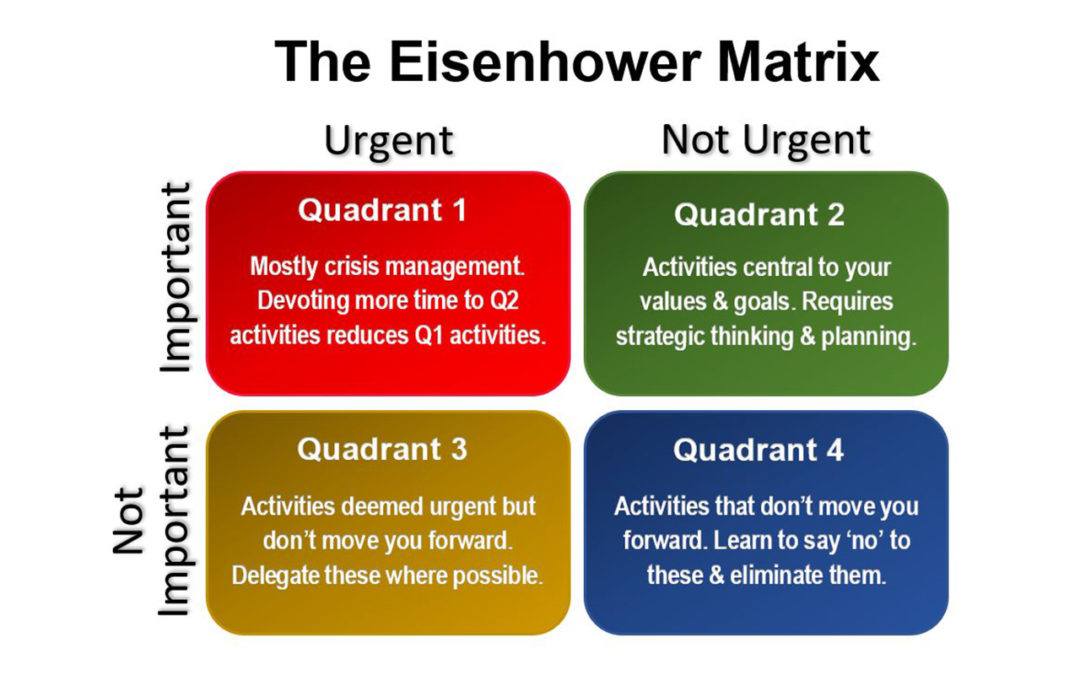
By Dr. Daniel Bobinski
Time and again we hear about the need for good time management, but if we examine that phrase, we realize it’s not accurate. Every person on the planet gets the same amount of time every day: 24 hours. Nobody gets more, nobody gets less, and no matter how much we try, we cannot speed up nor slow down time. In truth, what we’re really talking about with “time management” is managing our actions.
With that in mind, the third habit of Steven Covey’s book, “7 Habits of Highly Effective People,” is “Put First Things First.” A good tool to help us do this is the Eisenhower Matrix, which examines each task we do with two criteria. By way of review, those criteria are urgency and importance.
Urgent activities are things that require immediate attention.
Important activities are those that contribute to our mission, values and high-priority goals.
The Eisenhower Matrix gives us four categories, or quadrants. They are:
- Quadrant 1: Urgent – Important
- Quadrant 2: Not Urgent – Important
- Quadrant 3: Urgent – Not Important
- Quadrant 4: Not Urgent – Not Important
Essentially, the matrix provides a framework for how to organize our work and prioritize the most important tasks. Again, think task management instead of time management.
Quadrant 1 tasks (urgent and important) are those that impact our long-term goals but have immediate negative consequences if they’re not done. It’s recommended that people learn to differentiate Quadrant 1 from Quadrant 3 tasks (Urgent and Non-Important), which are things that are deemed urgent but don’t necessarily help us reach our long-term goals.
Most people spend a lot of time in Quadrant 1, mainly because they don’t take time to schedule and prioritize important but non-urgent items (Quadrant 2). The main problem with Quadrant 1 activities is they tend to stress us out. Know that Quadrant 1 items will never totally disappear, but we can minimize the quantity of Quadrant 1 items by incorporating more Quadrant 2 activities into our calendar. This is what Covey meant when he said we shouldn’t prioritize our schedule, but rather schedule our priorities.
People often ask, “I’d love to eliminate the stressful Quadrant 1 tasks by doing more Quadrant 2 tasks, but where can I possibly find the time?”
The answer to that question is fairly straightforward: Eliminate Quadrant 4 activities and delegate Quadrant 3 activities. Quadrant 4 actions are not important and not urgent (such as computer games), so why do them? The answer is we often do Quadrant 4 activities as a mental break from doing stressful Quadrant 1 things! Once we’re aware of that, we can consciously choose to do more Quadrant 2 things instead of Quadrant 4.
We can also make room for Quadrant 2 tasks if we delegate Quadrant 3 activities. Turning over urgent but not-important things to someone else can be a great way to develop skills in others.
Why not take the next week and inventory your tasks? By prioritizing Quadrant 2 tasks, we end up making better use of our time.
-Dr. Daniel Bobinski, M.Ed. is a best-selling author and a popular speaker at conferences and retreats. For more than 30 years he’s been working with teams and individuals (1:1 coaching) to help them achieve excellence. He was also teaching Emotional Intelligence since before it was a thing. Reach Daniel by email at DanielBobinski@protonmail.com or his office at 208-375-7606.










